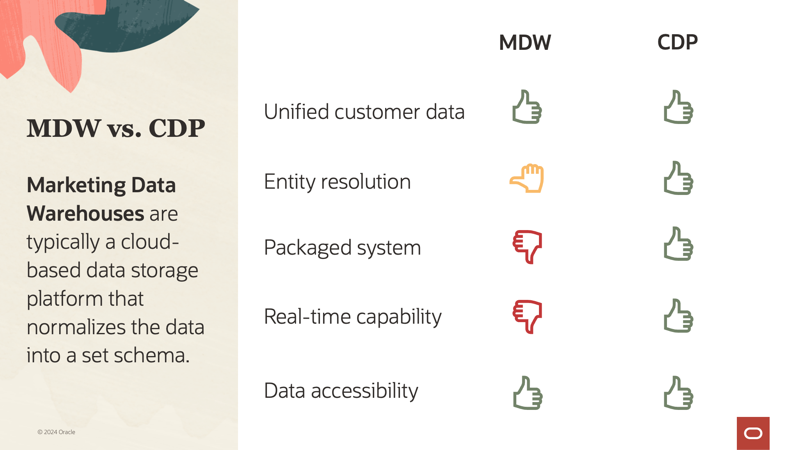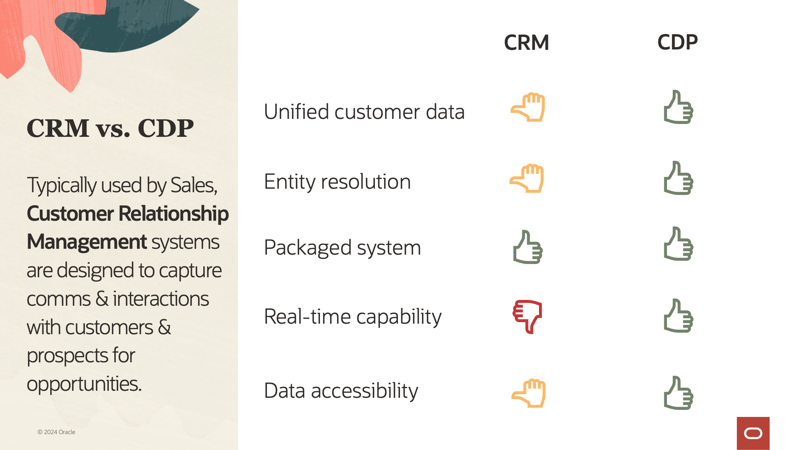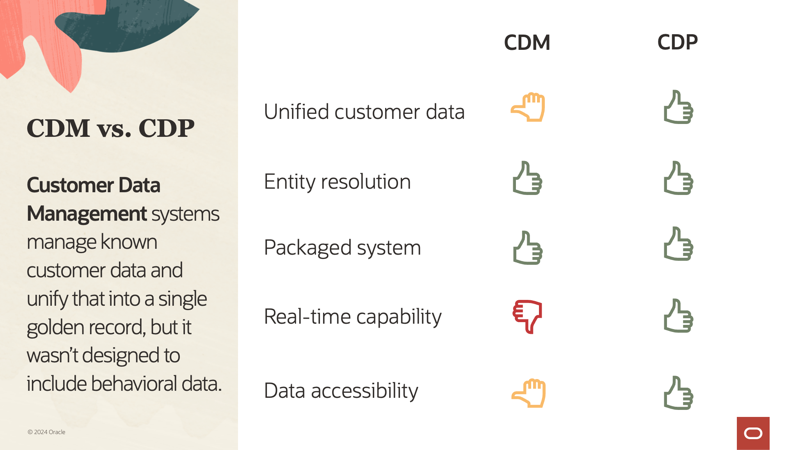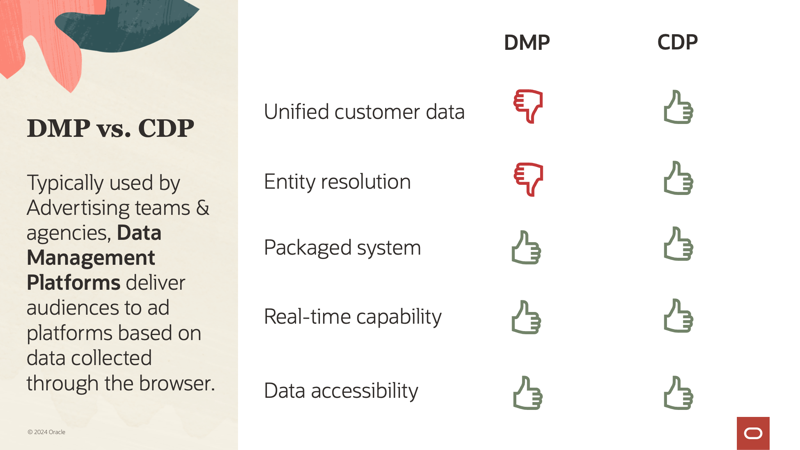When it comes to managing your customer data, brands have many options. However, all of those options are not created equal. Key differences are not always easy to identify, especially when solutions have legitimate overlap in some characteristics and functionality. This confusion is particularly acute around customer data platforms (CDPs) and adjacent technologies, which is raising doubts among brands as to which solutions truly meet their needs.
Let’s examine how CDPs like Oracle Unity stack up against marketing data warehouses (MDW), customer relationship management (CRM) systems, customer data management (CDM) systems, and data management platforms (DMPs). But first, let’s look at…
The 5 Characteristics of a CDP
It’s these characteristics that define how CDPs are different from other solutions. Its 5 characteristics are that it…
- Unifies customer data. CDPs ingest data across various systems—from both digital and offline sources, and from both front office and back office systems
- Provides entity resolution. CDPs are able to de-dupe and link data together based on customer, account, household, vehicle, and other information.
- Is a packaged system. Rather than pieced together by IT, CDPs include ID resolution, segmentation, activation, and data science in one packaged solution.
- Has real-time capability. The customer data in a CDP is updated and accessible in real-time.
- Provides data accessibility. CDP data is accessible to other systems for activation, analysis, and managing customer experiences.
Now that we’re clear on what a CDP is, let’s look at how other solutions compare.
MDW vs. CDP
Marketing data warehouses (MDWs) are solutions deploying a set of functional tools from various third-party vendors on top of a unified data storage platform that normalizes the data and data structure to meet specific marketing requirements, such as Identity resolution, campaign management, analytics, and reporting. The business rules and data structures are typically rigid, and require extensive IT or vendor resources to address any new solution components, data sources, data structures, or business requirements. Access to the environment is normally isolated to marketing resources.
MDWs also use external identity vendor solutions as part of the overall functional solution architecture, which require large, sensitive data sets to be transferred in and out of the system on a regular cadence. Due to their batch-oriented approach to data incorporation and processing, MDWs also aren’t usually able to react in real-time and present information as an experience is happening. So, as you can see, there is some overlap, but still some limitations when comparing what they can do to what a CDP can do.

CRM vs. CDP
Typically, customer relationship management (CRM) systems are used by sales and marketing organizations to identify sales opportunities. They’re designed to capture communications, key interactions, key data elements around accounts, contacts and leads or opportunities. These interactions can occur over the phone, by email, on social media, via web chat, or on a website.
The kinds of data collected include contact information and a history of a contact’s interactions with the brand, including all purchases. The data collected can help you analyze the sales pipeline and conduct forecasting, craft a personalized customer experience (CX), and foster a positive relationship with the customer.
Unlike a marketing data warehouse, CRMs are a package solution. They typically have ways to easily ingest data. Typically, they can be organized around accounts and they have the ability to add people. They provide a unified view around those entities, but definition of the entity is often at the discretion of the data source, which is often a salesperson or marketing lead generation process.
CRMs are another form of data silo, because their data isn’t necessarily broadly accessible, which means some details stay trapped within the sales organization. Cleaning CRM data is more difficult and there’s no real way to dedupe or organize customers and accounts directly within the platform. CRMs are also not designed to track unfamiliar or anonymous users, which makes gathering data on these users difficult. So, there are some difficulties there, where a CDP can provide more value and provide unique profiles and unique accounts, depending on the need.

How to Transform Your Customer Experience with a CDP.
CDM vs. CDP
Customer data management (CDM) systems are designed to bring together data across an organization. Typically, though, this data collection is batched, rather than real-time. This means that other systems don’t have access to real-time data from a CDM.
CDMs also have difficulty scaling, so they struggle with the data volumes that many companies are now managing. They also have a difficult time with unknown customers, such as someone who’s coming to your website and hasn’t provided any login information or specific PII-based information. CDMs aren’t designed to manage anything other than known customer information, so it’s difficult to pull in anonymous and pseudo-anonymous behaviors, unlike with CDPs.

DMP vs. CDP
Data management platforms (DMPs) were created around building audiences for advertising solutions. They are able to collect data in real time from first- and third-party cookies and other tracking sources, as well as information from data providers, managers, and services—and then deliver that back out into advertising channels, allowing you to target people who have recently visited your site.
While they’re great at managing data in real time, they’re not designed to focus on personal identifiable information. That makes resolving identities to individuals or back to accounts or other entities difficult in these platforms. In addition, due to the unstructured, voluminous nature of the data being collected, along with the reliance on transient identifiers such as cookies, most DMPs only keep a very short history of activities related to profiles, and many impose heavy restrictions on bringing additional external data into their environments.

As you can see, each of those systems is quite different from a CDP, but that doesn’t mean they’re redundant. There are opportunities to use some of these systems in tandem with CDPs.
How to unlock the benefits of a CDP.
How These Systems Might Work Together
Just because these other systems can’t do what a CDP can do doesn’t mean you don’t need them. Let’s look at some examples of how CDPs can work with other systems, including ones we haven’t mentioned.
CDP + CRM
Paired with a CDP, a CRM platform can continue to operate in its native, operational capacity, supporting sales automation, closed-loop reporting on conversions, capturing sales activity, and triggering next-sales actions. The CDP can then draw data from a CRM and share information back with it. This allows the CDP to resolve identities, store customer and interaction data long term, and process and react to signals in real-time—all of which are shortcomings of CRMs.
CDP + DMP
Having some similar weaknesses, DMPs also benefit from a CDP’s ability to resolve identities, store customer and interaction data long term, and process and react to signals in real-time.
By leveraging a DMP as the middle-tier solution, the CDP can manage audience participation at a higher level than a DMP can, including identifying and managing entities that might not have an online presence or ability to be targeted online. Then those audiences are passed to DMP, which targets those that are matched through potentially thousands of downstream activation partners for digital advertising.
CDP + Data Lake
Data lakes work well with customer data platforms as you will have other data and other reports your business will want to run that a CDP is not going to run. For example, CDPs don’t store or analyze your inventory trends, general ledger entries, financial reporting, or real estate forecasting.
Data lakes can also take on the work related to data normalization and standardization, so business rules are consistently applied across the organization. By pre-processing data in an upstream data lake and sourcing data from that environment into the CDP, it can ensure that data—and the intelligence drawn from it—are consistent between all enterprise data solutions.
Also, if you’re going to run some especially intense analytics on your customer data, exporting that data to a data lake can avoid the analysis slowing down your CDP.
Take a deeper dive into how data lakes and CDPs can work together.
CDP + CDP?
We sometimes encounter companies that have more than one customer data platform. Sometimes this is because the B2C division and B2B division each implemented their own CDP. Other times, this enterprise solution is being treated as a departmental solution.
We see this as undermining one of the key benefits of a CDP, which is creating a single source of truth about your customers. If you have two, which is the single source? You don’t have one. You have two data silos instead.
If your second CDP is giving you capabilities your first one doesn’t have, you should consider consolidating on the second rather than paying for and maintaining two CDPs.
And in the case of having separate B2C and B2B CDPs, would you treat your B2C customers differently if you discovered they were employees at one of the companies that is a customer or prospect of your B2B division? Those are the kinds of insights you’d be missing out on, in addition to perpetuating data silos and unnecessary complexity.
In many ways, if you have more than one CDP, you don’t technically have a CDP at all.
What Will Work Best for You?
There’s no one-size-fits-all answer to this question. Depending on your industry and your individual needs—as well as the solution stack you currently have—multiple potential combinations may work for your organization.
But there’s the point of emphasis: When you talk about customer data platforms and some of these other solutions, you’re talking about enterprise solutions. That means you need input and engagement from across the organization to understand your current and future needs and to chart a course forward with the right solutions.
—————
Need help with your tech stack or data management? Oracle Digital Experience Agency has hundreds of marketing and communication experts ready to help Responsys, Eloqua, Unity, and other Oracle customers create stronger connections with their customers and employees—even if they’re not using an Oracle platform as the foundation of that experience. With a 94% satisfaction rate, our clients are thrilled with the award-winning work our creative, strategy, and other specialists do for them, giving us an outstanding NPS of 82.
For help overcoming your challenges or seizing your opportunities, talk to your Oracle account manager, visit us online, or email us at OracleAgency_US@Oracle.com.
Now completely updated, this blog post was originally published on Nov. 12, 2021 by Michael McNichols.

